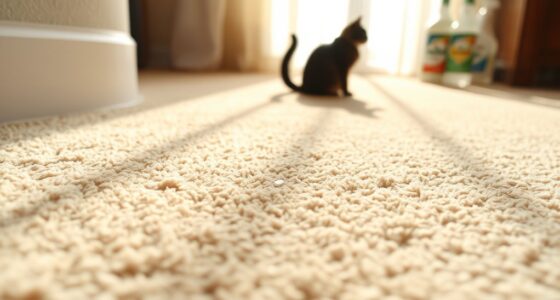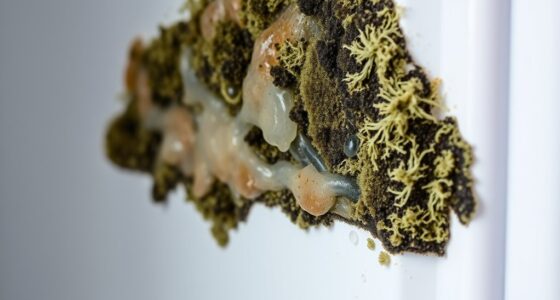A top-down dusting strategy is key to effective cleaning. Start by dusting high surfaces like ceiling fans and light fixtures to prevent dust from falling onto lower areas. Next, move to walls and shelves, pushing dust downward and avoiding re-contamination. Finish with furniture and floors to capture settled dust. Following this order makes your cleaning more efficient and thorough. Keep going to discover how this simple technique can transform your cleaning routine.
Key Takeaways
- Dust high surfaces first to prevent dust from falling onto already cleaned areas.
- Follow a top-to-bottom sequence to ensure dust is displaced downward and not resettled.
- Cleaning from the ceiling to furniture minimizes airborne dust and re-contamination.
- Finish with floors to remove residual dust and prevent stirring up settled particles.
- Proper dusting order saves time and effort by reducing re-cleaning and ensuring thorough cleaning.

When it comes to dusting your home, the order in which you clean can make a big difference in how effective your effort is. Adopting a top-down strategy isn’t just about convenience; it’s a smart way to maximize airflow efficiency and reduce dust accumulation. Starting at the highest points of a room ensures that loose dust and debris fall downward, where they can be easily collected and removed without settling on already cleaned surfaces. This approach helps prevent dust from drifting onto freshly dusted areas, saving you time and effort.
As you begin your dusting routine, focus on ceiling fans, light fixtures, and shelves near the ceiling. These spots tend to gather the most dust because of their placement and exposure. When you wipe or dust these high surfaces first, the displaced particles will naturally fall downward, rather than settling onto furniture or floors. This downward fall of dust improves airflow efficiency because it minimizes airborne particles that tend to linger when you dust randomly or start from the bottom. By controlling the dust’s movement, you’re reducing the total dust accumulation on surfaces you’ve already cleaned.
After tackling the high surfaces, move on to walls and picture frames. Dusting these after the ceiling fixtures keeps loose particles from falling onto your furniture or floors. When you work from top to bottom, you’re ensuring that dust is gradually pushed downward, so you don’t have to revisit the same surface multiple times. This not only saves effort but also keeps the dust from resettling where you’ve already cleaned.
Next, focus on furniture and flat surfaces such as tables, countertops, and shelves. These are the areas where dust collects and settles after airborne particles have fallen from above. By cleaning these last, you’re catching the residual dust that’s settled out of the air, leading to a cleaner environment overall. This sequence enhances airflow efficiency because fewer airborne dust particles are left floating around, reducing the chance of them settling back onto clean surfaces.
Finally, don’t forget to vacuum or sweep the floors last. Since most dust and debris now reside on the surfaces above, you’ll pick up the residual dirt efficiently without stirring up dust into the air prematurely. This top-down approach ensures that dust doesn’t re-settle on freshly cleaned surfaces, making your entire dusting effort more thorough and effective. Following this order enables you to create a cleaner, healthier space while reducing the amount of dust that re-accumulates, ultimately making your cleaning routine more efficient and less frustrating.
Additionally, understanding the importance of best cleaning practices can help you optimize your routine and achieve better results.
Frequently Asked Questions
How Often Should I Change My Dusting Routine?
You should change your dusting routine based on your dusting frequency and seasonal dusting needs. Aim to dust weekly if you have allergies or pets, but shift to bi-weekly or monthly during less dusty seasons. Adjust for seasonal dusting by increasing frequency in spring and fall when pollen and dust tend to be higher. Regularly evaluating your environment helps you maintain a cleaner, healthier space.
What Tools Are Best for Effective Dusting?
You should choose the best tools for effective dusting by considering different duster types like microfiber, feather, and electrostatic dusters, which target dust efficiently. Use cleaning cloths, especially microfiber ones, for surfaces that need a gentle touch. Microfiber dusters trap dust better and are reusable, making your routine more eco-friendly. Combining these tools guarantees thorough cleaning and keeps dust from settling quickly, giving your space a fresher, cleaner feel.
Does Dusting Order Vary by Room Type?
Yes, dusting order varies by room type. You should adapt your dusting sequence based on each room’s specific methods and high-traffic areas. In living rooms, start with ceiling fans and shelves, then move to furniture. In bedrooms, dust bedding and lamps first. Following room-specific methods guarantees you efficiently remove dust without needing to redo areas. Tailoring your dusting sequence makes your cleaning more effective and less time-consuming.
Can Improper Dusting Cause Allergies to Worsen?
Ever wonder if improper dusting worsens allergies? It definitely can, because neglecting proper dusting methods can increase airborne allergens and dust accumulation. When you skip cleaning from top to bottom, dust falls onto surfaces below, spreading allergens into the air. This makes it harder for your body to manage allergy symptoms. To reduce this, dust thoroughly and systematically, avoiding stirring up dust that triggers allergies.
Are There Eco-Friendly Dusting Products Recommended?
Yes, there are eco-friendly alternatives you can use for dusting. Look for natural cleaning products made from plant-based ingredients that are safe for you and the environment. These natural cleaning products often come in biodegradable packaging and avoid harsh chemicals. Using eco-friendly alternatives not only reduces your chemical exposure but also helps protect the planet. Always check labels to ensure the products are truly sustainable and free from synthetic fragrances or toxins.
Conclusion
So, next time you dust, remember—starting from the top isn’t just about avoiding messes; it’s about mastering the art of neglect. Ironically, by following this simple order, you might just realize that the real dusting was on your priorities all along. Think about it: in your quest for a spotless home, it’s the overlooked spots that hold the secrets to truly clean spaces. Who knew that dusting top-down could reveal so much more than just dirt?









